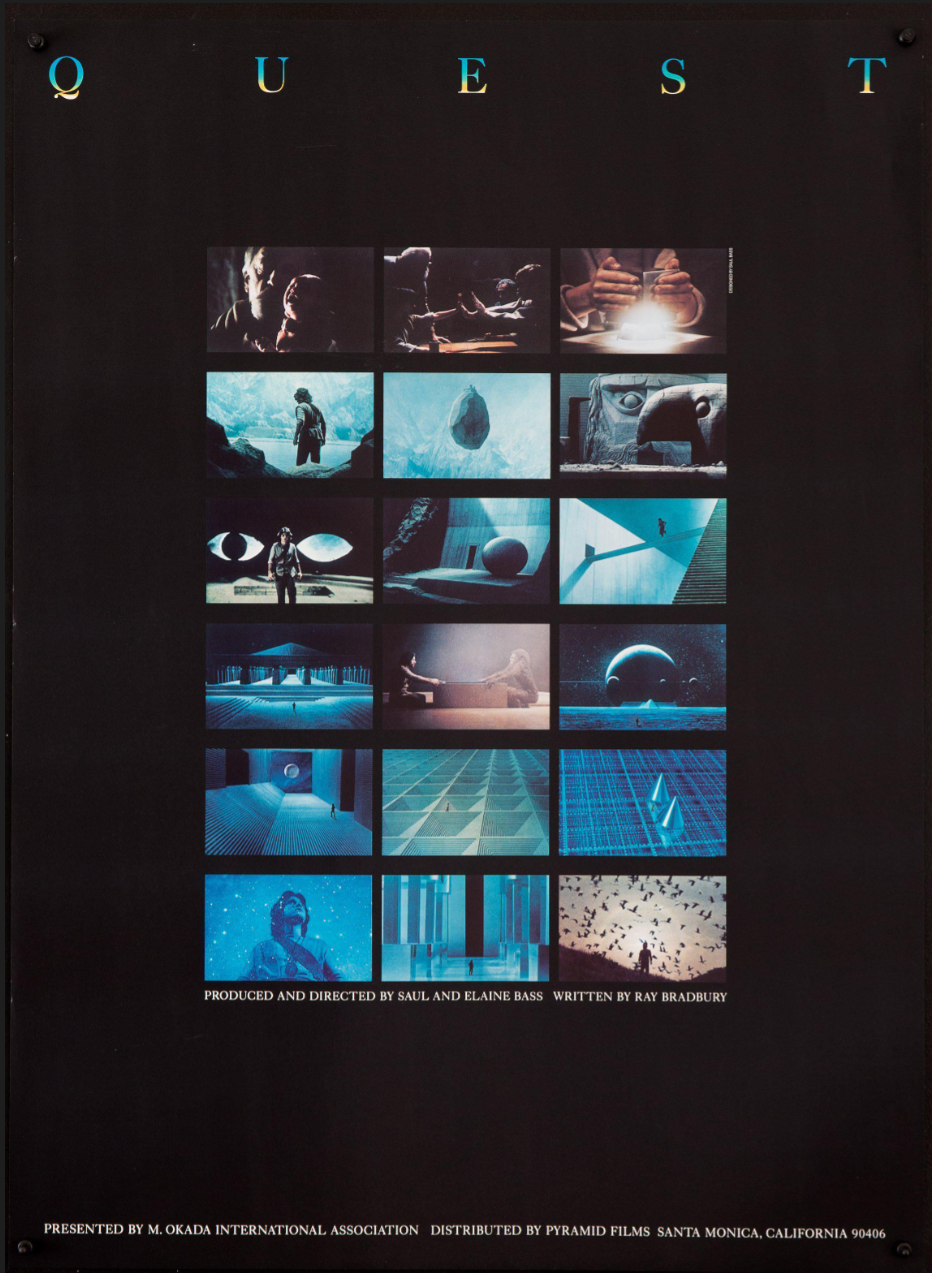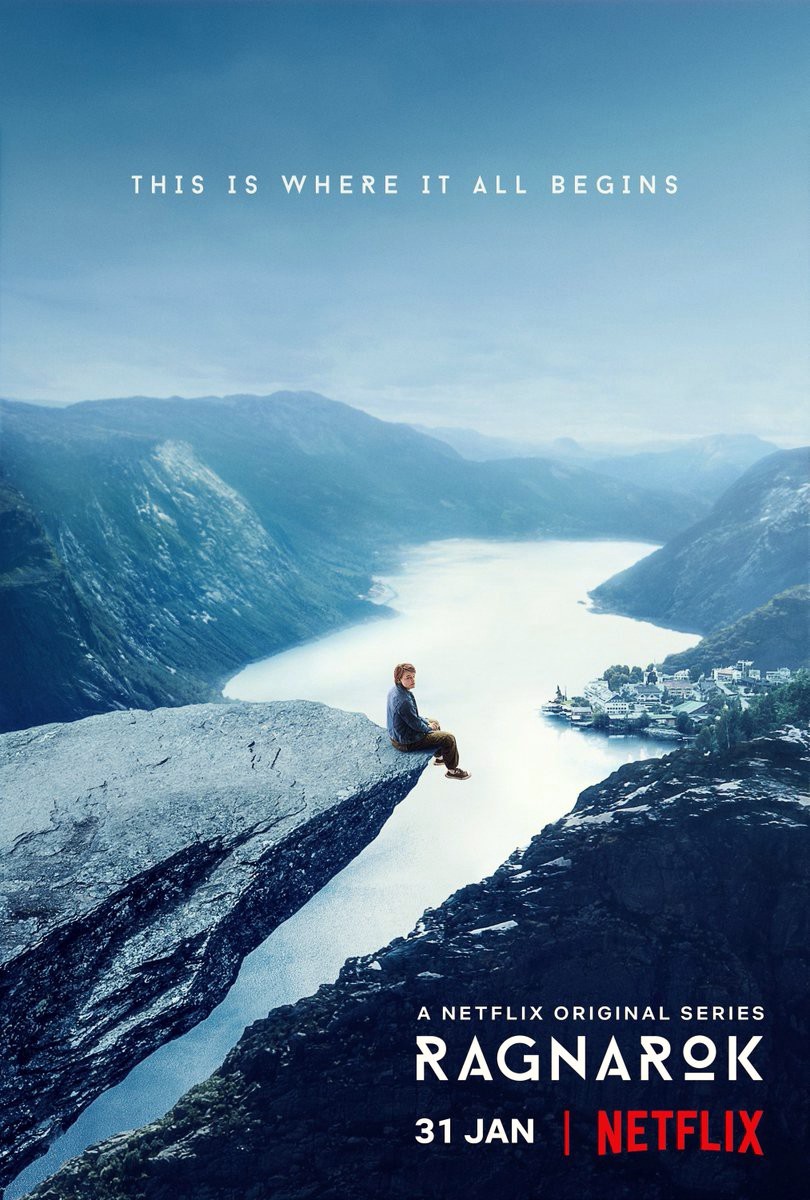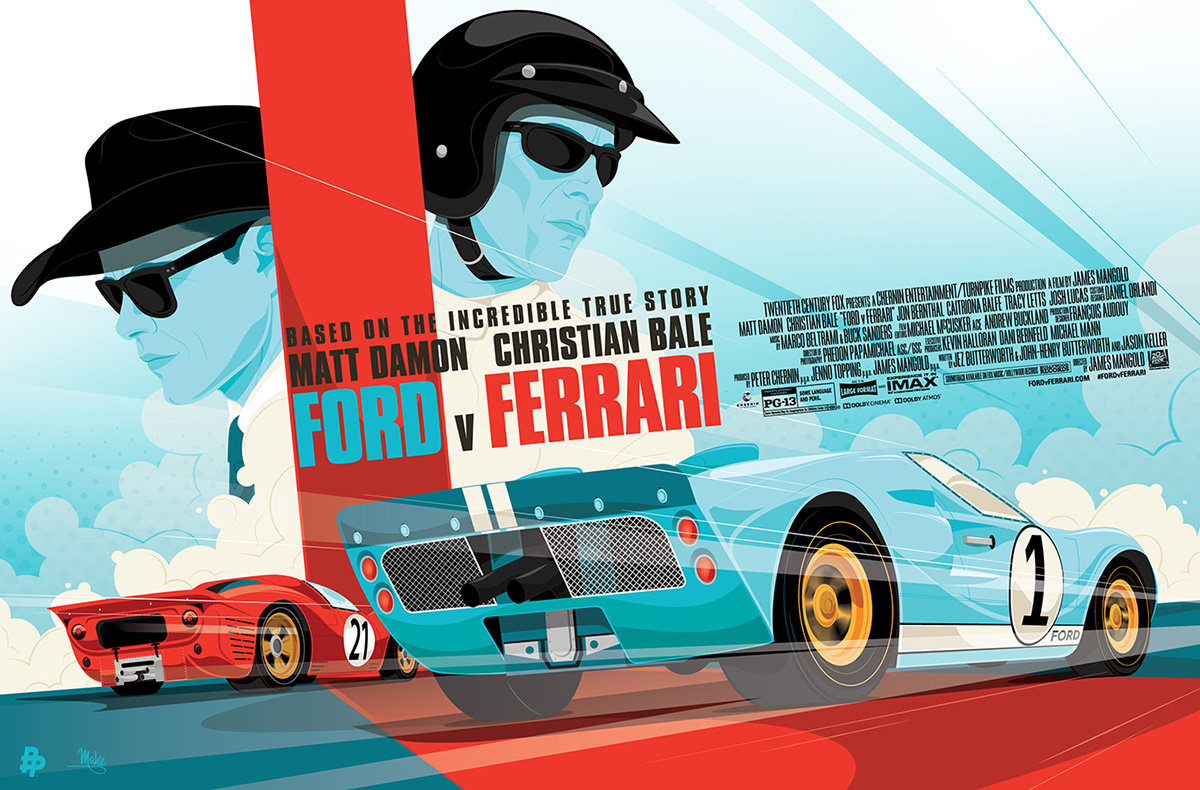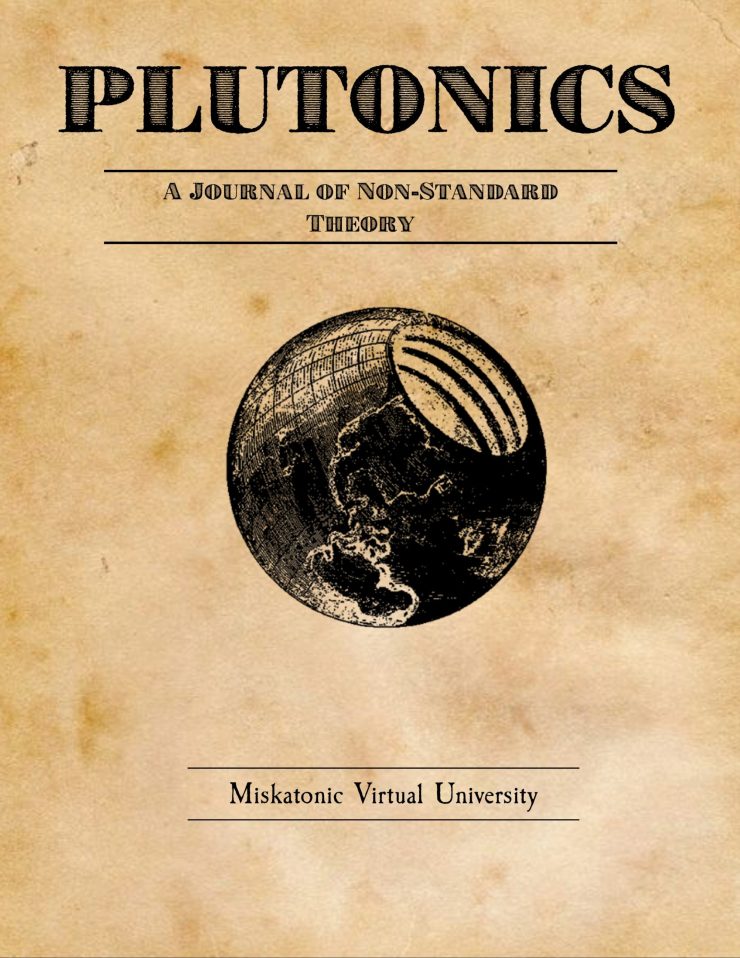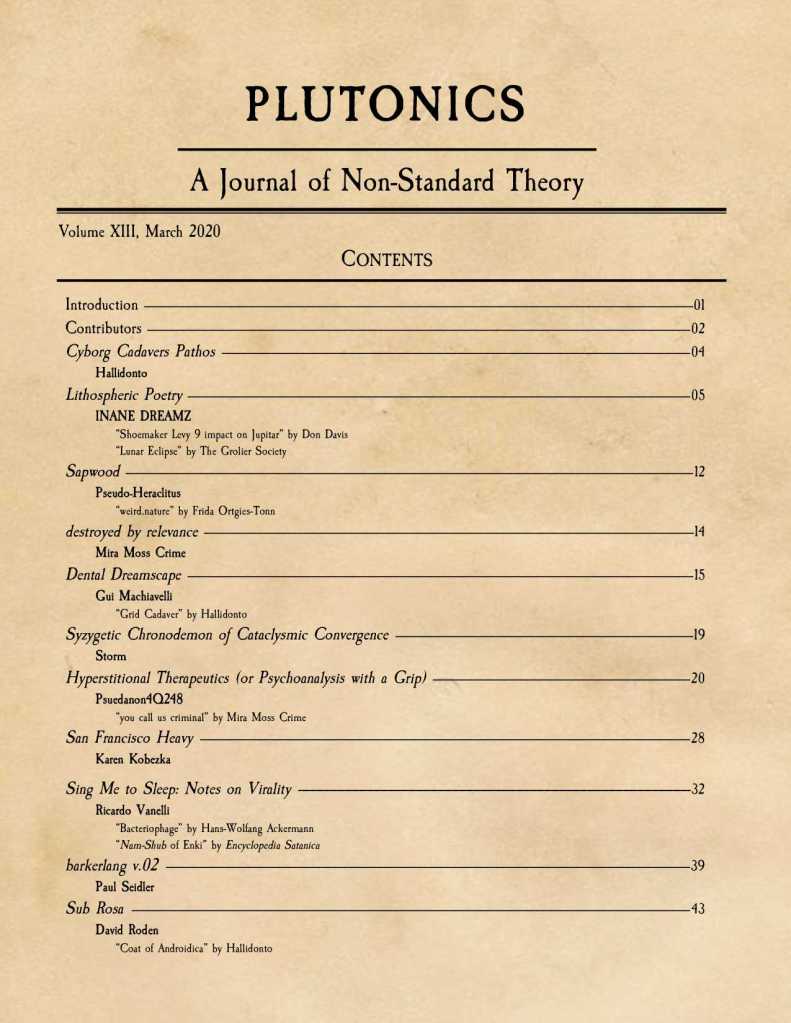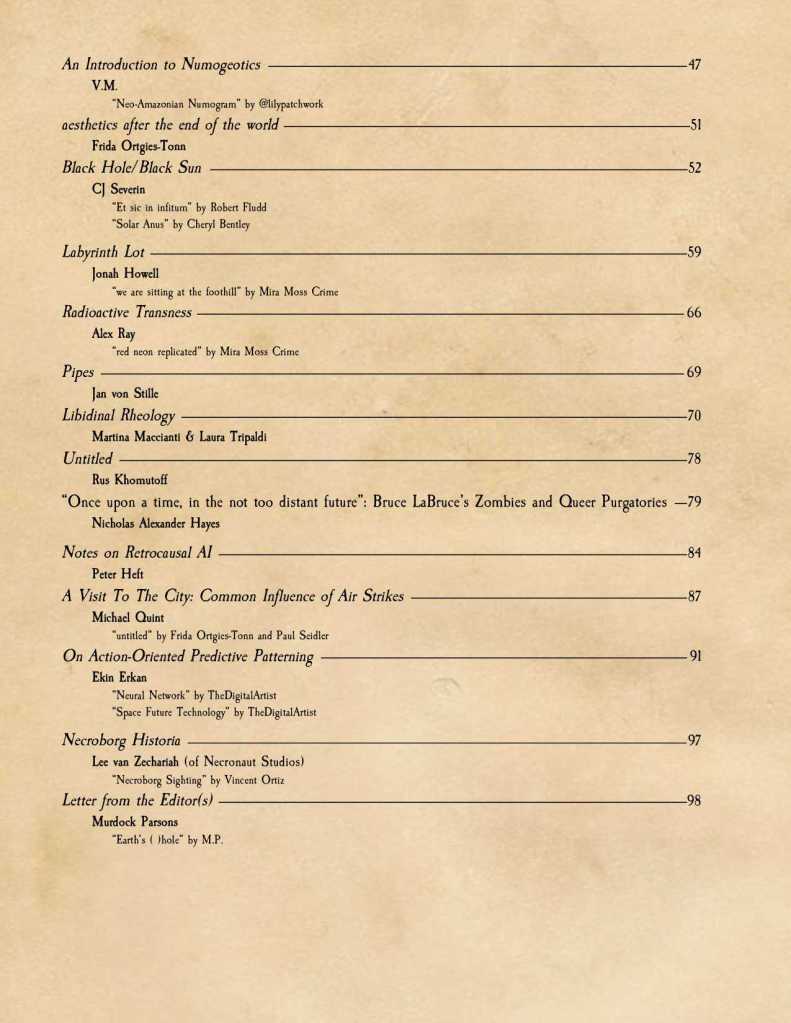Since at least 10+ years I have been zealously gathering books on the general topic of Bodies, Contagion, Dirt, Impurity and Hygiene, Cleanliness or Public Health. It would be wrong to try and squeeze this pandemic into previous precedents, also one can see the gap opening up where a lot of of these books might fall trough, feel unrelated, plain wrong or simply not what is most important stringent at the momentum. Old frames feel dated, conceptual work seems largekyto be done and theoretical groundwork needs go maybe take a pause (see MacKenzie Wark’s recent text). We’re currently swimming in contradictory affects, and any complete theory of affects would also invoke and take into account what have been relegated to the drawer of negative affects such as disgust, abhorrence and fear in regard to dirt, the abject, infection, putrefaction processes and the sliminess of biological matter. The purity/impurity interior/exteriori divide has been actively exploited and weaponized against the xeno-, the migrant, the mismeasured foreigner and the unwanted other.
A more subtle direction has followed a sense of fragility and of loss conceptualized within and growing out of a rich feminist studies tradition, offering us ways of grasping & attending to the un-graspable: impeding climate change catastrophe and 6th mass extinction. Hopefully these books will fan out a largely body of work, encouraging creative cross overs from Fecopoetics, STS, History of Medicine, Anthropology into gender studies and even metaphysics. By no means focused on just a social constructivist or strictly cultural or ideological reading of disease or contagion, while sometimes indebted to biopolitical critique, they point us beyond the limits & narrow confines of continental biopolitical thinking. Much of the the biopolitical thinking via Foucault, Agamben or Esposito seems somehow to have a lot it’s relevance or acuity when confronted with what is happening alm over the world. There are other ways of enlarging the scope of our current COVID-19/SARS CoV-2 response corresponds to different histories, more fecund and diverse bio-philosophical lines of thought developed under various disciplinary regimes, approaches and practices. In times of public health sector privatization, divestment from accessible medical research and disregard for the general health of the population, it is easy to ignore the positive role of public health systems or medical traditions played not only in modern but also non European or pre-modern contexts be they Buddhist, Chinese or Islamic.
One such historical and political litmus test of public health is the before/after 1989 disaffection of the public health, migration of doctors and lack of hygiene in hospitals in the ex Soviet Union and former East. Although taking into account the key moment of AIDS and the various theoretical and collective responses to it, especially in regard to how solidarity has marked so much of our thinking about preventable disease and contagion. They also follow virality & infection in other pre- biological or even non-biological directions (human-non-human/computer). Recently departing from microbial metaphors & representational thinking, some authors are asking for a more positive understanding of contagion & virality as demanded by an increasingly networked planet of complex assemblages. The introductory materials are compiled from online sources and goes without saying that it is by no means a complete list. I also added their Goodreads links.
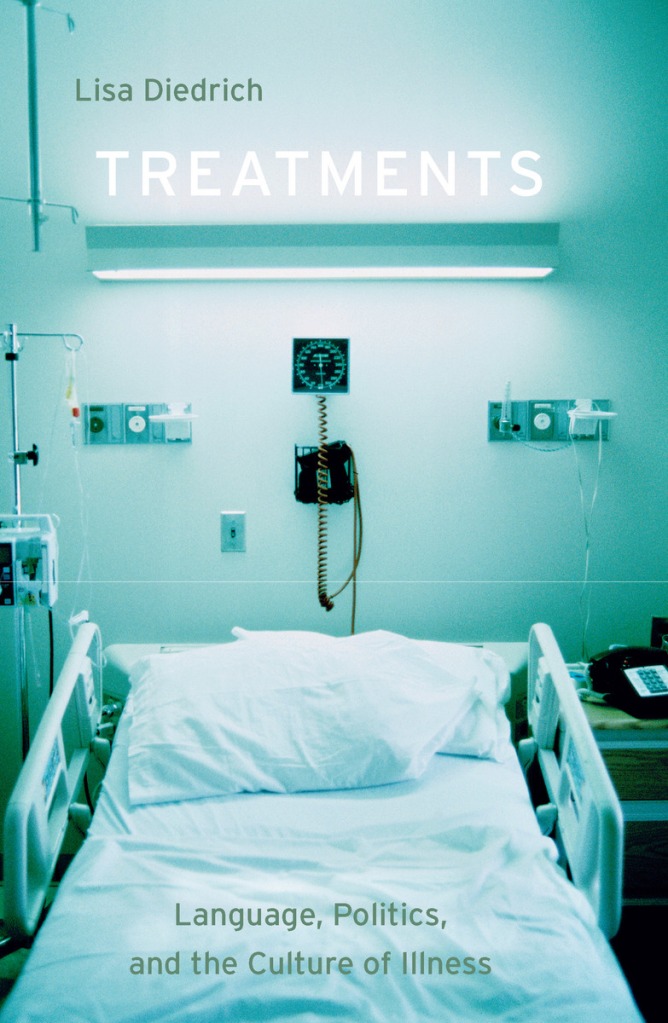
Title: Treatments: Language, Politics, and the Culture of Illness
Year: 2007
Author: Lisa Diedrich
Delving into the controversial relationship between illness and art, philosophy and politics Lisa Diedrich considers illness narratives, demonstrating that these texts not only recount symptoms but also describe illness as an event that reflects wider cultural contexts, including race, gender, class, and sexuality. Looking at narratives including Susan Sontag’s Illness As Metaphor, Audre Lorde’s The Cancer Journals, and Eve Kosofsky Sedgwick’s “White Glasses,” Diedrich demonstrates how language both captures and fails to capture these “scenes of loss.”
This powerful and illuminating study examines the myriad stories of illness that increasingly shape modern understandings of disease and suffering. In the compelling vision of Treatments, illness is no longer what patients have; it is also what they do.— Paula Treichler, author of How to Have Theory in an Epidemic: Cultural Chronicles of AIDS
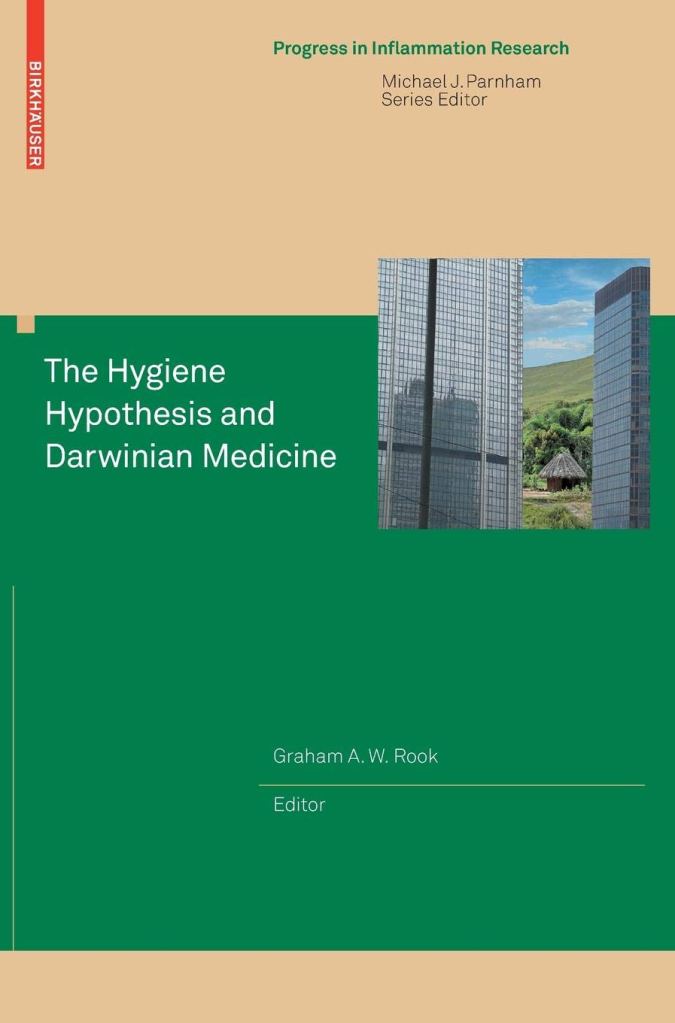
Title: The Hygiene Hypothesis and Darwinian Medicine
Year: 2009
Editors: Rook, Graham (Ed.)
Man has moved rapidly from the hunter-gatherer environment to the living conditions of the rich industrialised countries. The hygiene hypothesis suggests that the resulting changed and reduced pattern of exposure to micro-organisms has led to disordered regulation of the immune system, and hence to increases in certain chronic inflammatory disorders. The concept began with the allergic disorders, but there are now good reasons for extending it to autoimmunity, inflammatory bowel disease, atherosclerosis, depression associated with raised inflammatory cytokines, some cancers and perhaps neuroinflammatory disorders such as Alzheimer’s and Parkinson’s.
This book discusses the evidence for and against in the context of Darwinian medicine, which uses knowledge of evolution to cast light on human diseases. It is the first book to consider the broader implications of the hygiene hypothesis in areas of medicine where it has not previously been applied. The approach is interdisciplinary, looking at man’s microbiological history, at the biology of the effects of microorganisms on the immune system, and at the implications for chronic inflammatory disorders in multiple organ systems. Finally, the authors describe progress in the exploitation of microorganisms or their components as novel prophylactics and treatments in several branches of medicine.
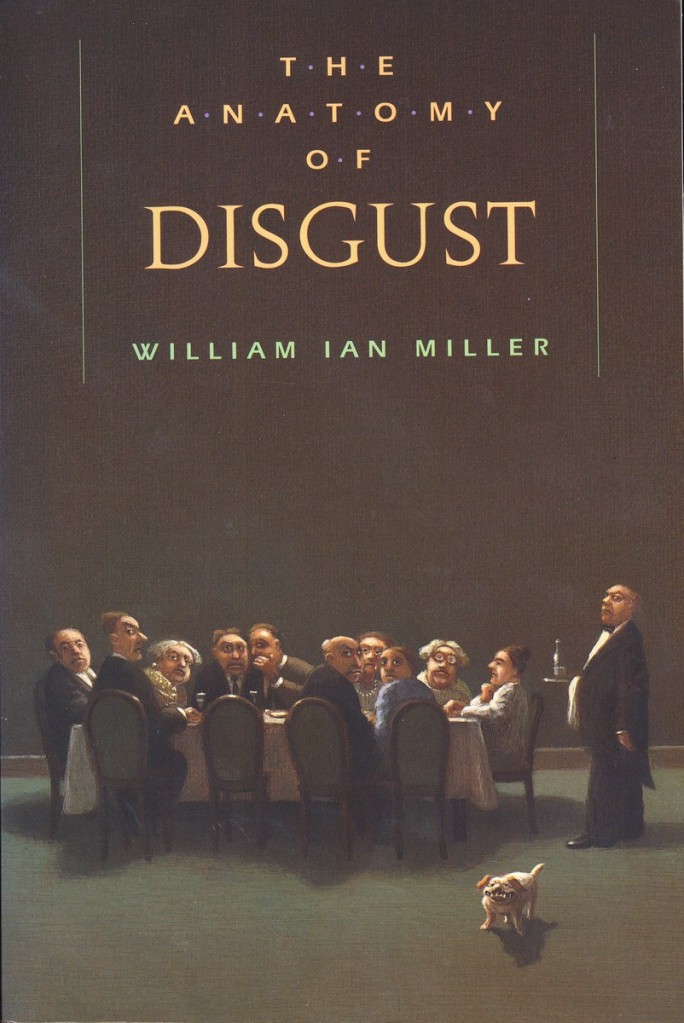
Title: The Anatomy of Disgust
Year: 1997
Author: William Miller
William Miller embarks on an alluring journey into the world of disgust, showing how it brings order and meaning to our lives even as it horrifies and revolts us. Our notion of the self, intimately dependent as it is on our response to the excretions and secretions of our bodies, depends on it. Cultural identities have frequent recourse to its boundary-policing powers. Love depends on overcoming it, while the pleasure of sex comes in large measure from the titillating violation of disgust prohibitions. Imagine aesthetics without disgust for tastelessness and vulgarity; imagine morality without disgust for evil, hypocrisy, stupidity, and cruelty.
Miller details our anxious relation to basic life processes: eating, excreting, fornicating, decaying, and dying. But disgust pushes beyond the flesh to vivify the larger social order with the idiom it commandeers from the sights, smells, tastes, feels, and sounds of fleshly physicality. Disgust and contempt, Miller argues, play crucial political roles in creating and maintaining social hierarchy. Democracy depends less on respect for persons than on an equal distribution of contempt. Disgust, however, signals dangerous division. The high’s belief that the low actually smell bad, or are sources of pollution, seriously threatens democracy.
Miller argues that disgust is deeply grounded in our ambivalence to life: it distresses us that the fair is so fragile, so easily reduced to foulness, and that the foul may seem more than passing fair in certain slants of light. When we are disgusted, we are attempting to set bounds, to keep chaos at bay. Of course we fail. But, as Miller points out, our failure is hardly an occasion for despair, for disgust also helps to animate the world, and to make it a dangerous, magical, and exciting place.
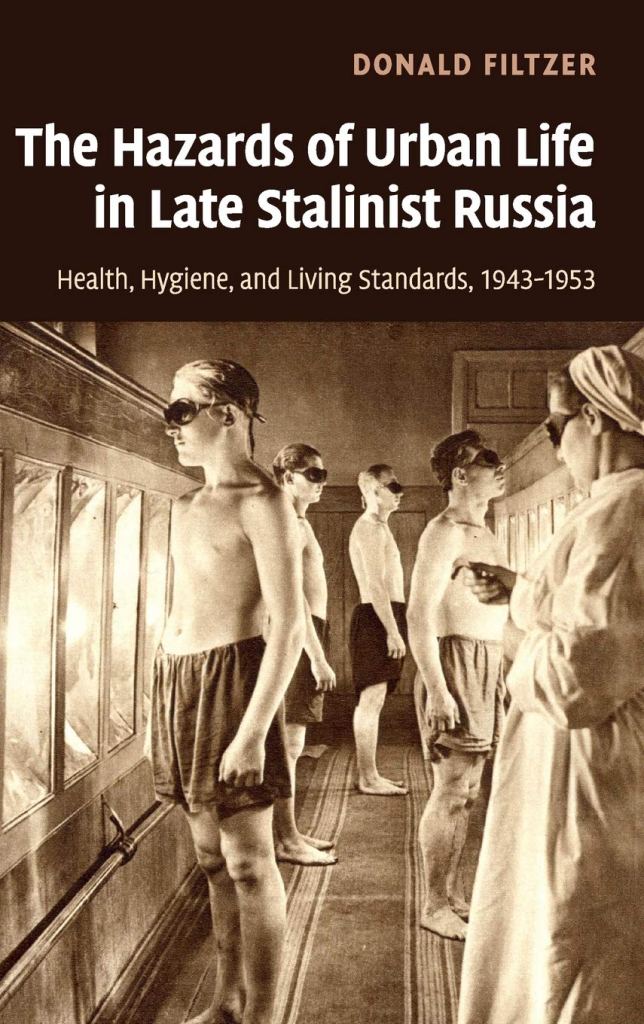
Title: The Hazards of Urban Life in Late Stalinist Russia: Health, Hygiene, and Living Standards 1944-1953
Year: 2010
Author: Donald Filtzer
This is the first detailed study of the standard of living of ordinary Russians following World War II. It examines urban living conditions under the Stalinist regime with a focus on the key issues of sanitation, access to safe water supplies, personal hygiene and anti-epidemic controls, diet and nutrition, and infant mortality. Comparing five key industrial regions, it shows that living conditions still lagged some fifty years behind Western European norms. The book reveals that, despite this, the years preceding Stalin’s death saw dramatic improvements in mortality rates thanks to the application of rigorous public health controls and Western medical innovations. While tracing these changes, the book also analyzes the impact that the absence of an adequate urban infrastructure had on people’s daily lives and on the relationship between the Stalinist regime and the Russian people, and, finally, how the Soviet experience compared to that of earlier industrializing societies.
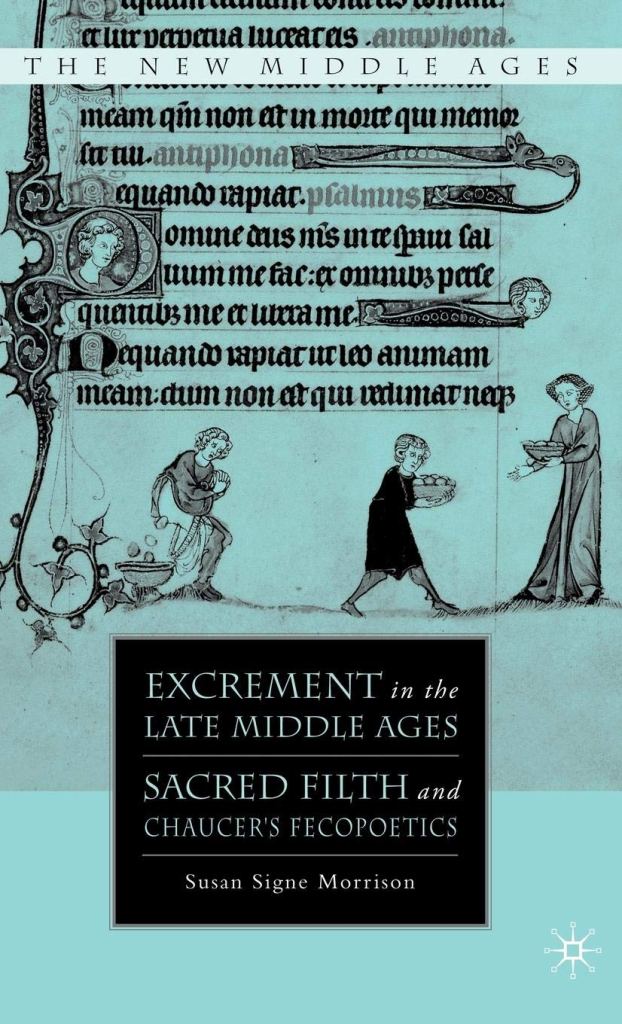
Title: Excrement in the Late Middle Ages: Sacred Filth and Chaucer’s Fecopoetics
Year: 2008
Author: Susan Signe Morrison
This interdisciplinary book intergrates the historical practices regarding material excrement and its symbolic representation, concluding that excrement is a moral and ethical category deserving scrutiny.
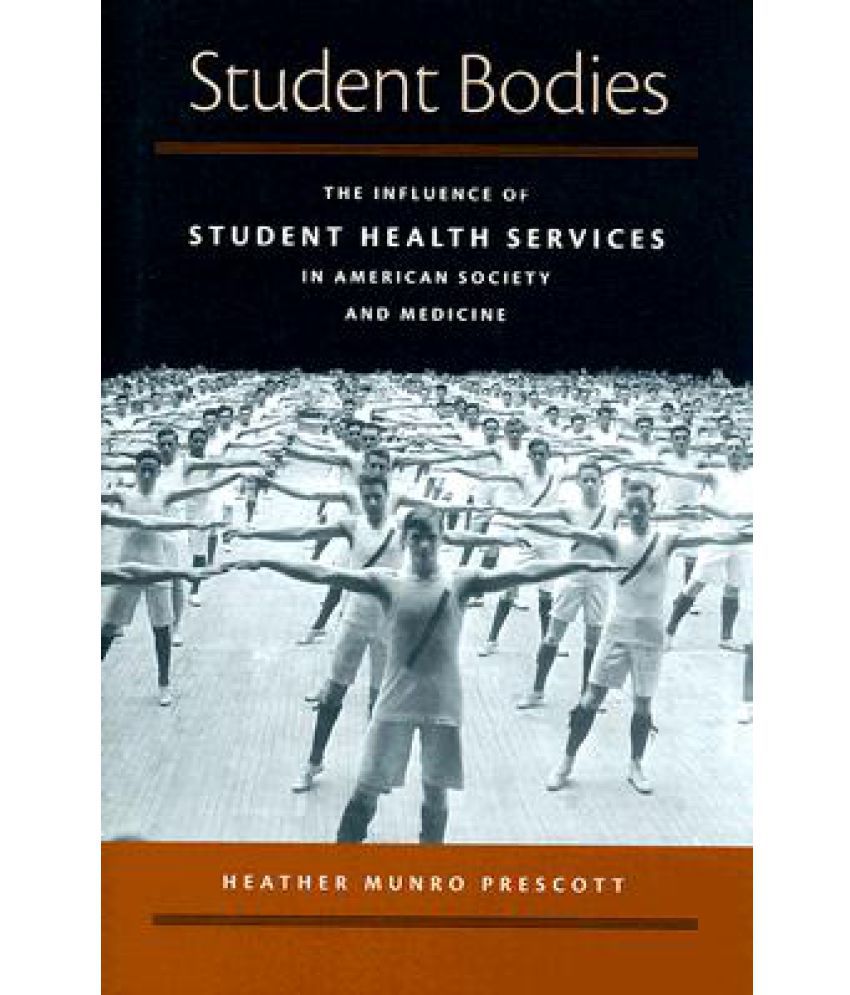
Title: The Influence of Student Health Services in American Society and Medicine
Year: 2007
Author: Heather Munro Prescott
Student Bodies is the first book to link developments in college health with larger trends in American cultural and medical history. This comprehensive and engrossing study describes the origins and development of health services at institutions of higher education in the United States from the early 1800s—when administrators sought to restrict habits “unfavorable to study and morality” such as drunkenness, gambling, and solicitation of prostitutes—to the present day as health professionals are called on to combat issues ranging from sexually transmitted diseases to depression to eating disorders. Drawing on a variety of primary sources, Professor Heather Munro Prescott examines the relationship between administrative regulation of “student bodies” and broader social-cultural views about young adults and their status in nineteenth- and twenty-first-century America.
Student Bodies explores many little-known but significant aspects of college health—including the importance of women’s colleges in the development of student care, the use of physical entrance examinations to deny admission to those with “undesirable” bodies, the sometimes controversial handling of health concerns specific to minority and LGBT students, and the rise and fall of in loco parentis. Prescott’s engaging and accessible style makes this guide a perfect choice for medical scholars and college administrators as well as anyone wishing to gain a better understanding of medical history, women’s health, and the history of college life in America.
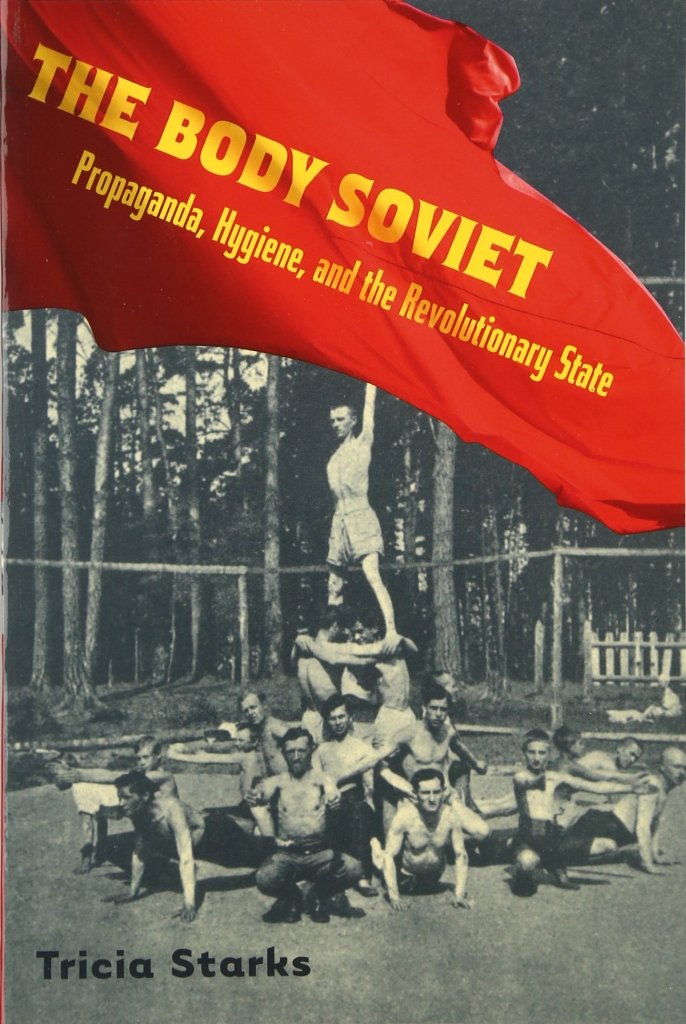
Title: The Body Soviet: Propaganda, Hygiene, and the Revolutionary State
Year: 2009
Author: Tricia Starks
“The Body Soviet is the first sustained investigation of the Bolshevik government’s early policies on hygiene and health care in general.”
—Louise McReynolds, author of Russia at Play: Leisure Activities at the End of the Tsarist Era
In 1918 the People’s Commissariat of Public Health began a quest to protect the health of all Soviet citizens, but health became more than a political platform or a tactical decision. The Soviets defined and categorized the world by interpreting political orthodoxy and citizenship in terms of hygiene. The assumed political, social, and cultural benefits of a regulated, healthy lifestyle informed the construction of Soviet institutions and identity. Cleanliness developed into a political statement that extended from domestic maintenance to leisure choices and revealed gender, ethnic, and class prejudices. Dirt denoted the past and poor politics; health and cleanliness signified mental acuity, political orthodoxy, and modernity.
Health, though essential to the revolutionary vision and crucial to Soviet plans for utopia, has been neglected by traditional histories caught up in Cold War debates. The Body Soviet recovers this significant aspect of Soviet thought by providing a cross-disciplinary, comparative history of Soviet health programs that draws upon rich sources of health care propaganda, including posters, plays, museum displays, films, and mock trials. The analysis of propaganda makes The Body Soviet more than an institutional history; it is also an insightful critique of the ideologies of the body fabricated by health organizations.
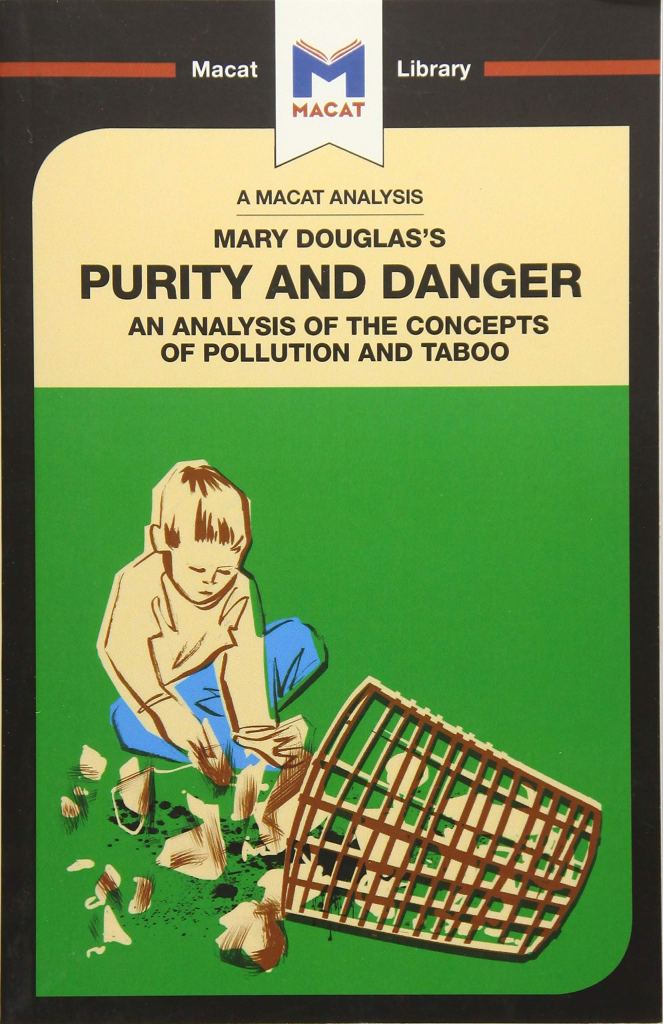
Title: Purity and Danger: An Analysis of the Concepts of Pollution and Taboo
Year: 1966
Author: Mary Douglas
Free book here
The line of inquiry in Purity and Danger traces the words and meaning of dirt in different contexts. What is regarded as dirt in a given society is any matter considered out of place. (Douglas took this lead from William James.) She attempted to clarify the differences between the sacred, the clean and the unclean in different societies and times. But this does not entail judging religions as pessimistic or optimistic in their understanding of purity or dirt—e.g., as dirt-affirming or otherwise. Through a complex and sophisticated reading of ritual, religion, and lifestyle, Douglas challenged Western ideas of pollution, making clear how the context and social history is essential.
As an example of this approach, Douglas first proposed that the kosher laws were not, as many believed, either primitive health regulations or randomly chosen as tests of the Israelites‘ commitment to God. Instead, Douglas argued that the laws were about symbolic boundary-maintenance. Prohibited foods were those that did not seem to fall neatly into any category. For example, pigs‘ place in the natural order was ambiguous because they shared the cloven hoof of the ungulates, but did not chew cud.
Later in a 2002 preface to Purity and Danger, Douglas went on to retract this explanation of the kosher rules, saying that it had been “a major mistake.” Instead, she proposed that “the dietary laws intricately model the body and the altar upon one another.” For instance, among land animals, Israelites were only allowed to eat animals that were also allowed to be sacrificed: animals that depend on herdsmen. Douglas concluded from this that animals that are abominable to eat are not in fact impure, but rather that “it is abominable to harm them.” She claimed that later interpreters (even later Biblical authors) had misunderstood this.
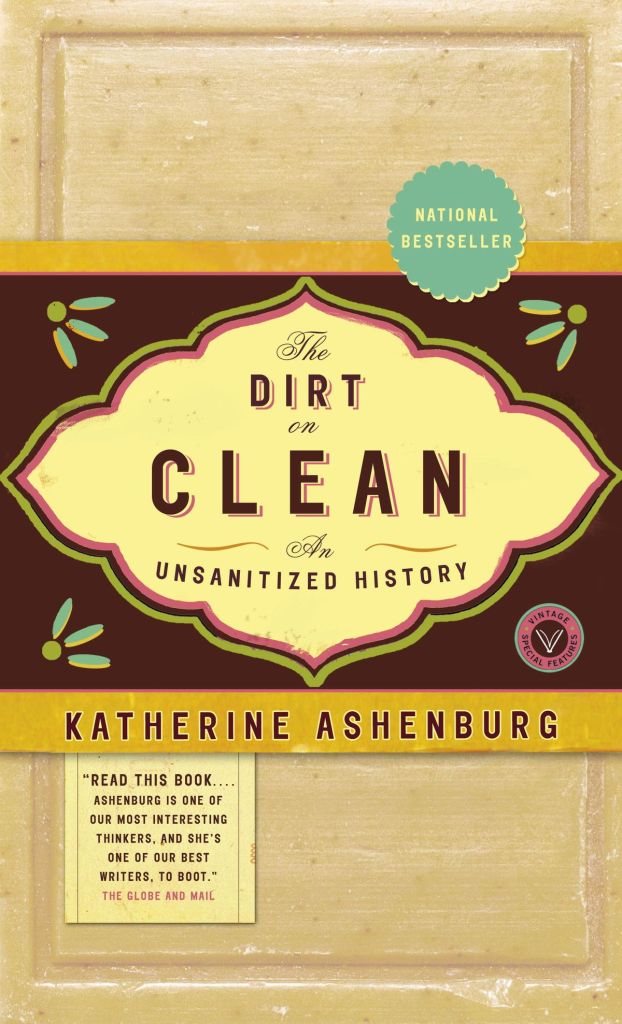
Title: The Dirt on Clean: An Unsanitized History
Year: 2009
Author: Katherine Ashenburg
Goodreads
The apparently routine task of taking up soap and water (or not) is Katherine Ashenburg’s starting point for a unique history of private life. Every age and culture was convinced that their version of cleanliness was the correct one, from the Roman who spent a few hours a day soaking in public baths of various temperatures to the 17th-century Frenchman who never touched water and believed he cleaned himself by changing into a fresh linen shirt. Our own over-deodorized world — where germophobes shake hands with their elbows and where sales of hand sanitizers, wipes and sprays are skyrocketing — is as extreme, and potentially unhealthy, as the 17th century. And, as with every other age, our definition of “clean” says much about us. Filled with amusing anecdotes and unexpected insights into our notions of privacy, health, individuality, religion and sexuality, The Dirt on Clean takes us on a journey that is by turns intriguing, startling, humorous — and not always for the squeamish.
The apparently routine task of taking up soap and water (or not) is Katherine Ashenburg’s starting point for a unique exploration of Western culture, which yields surprising insights into our notions of privacy, health, individuality, religion and sexuality.
Ashenburg searches for clean and dirty in plague-ridden streets, medieval steam baths, castles and tenements, and in bathrooms of every description. She reveals the bizarre rescriptions of history’s doctors as well as the hygienic peccadilloes of kings, mistresses, monks and ordinary citizens, and guides us through the twists and turns to our own understanding of clean, which is no more rational than the rest. Ashenburg’s tour of history’s baths and bathrooms reveals much about our changing and most intimate selves — what we desire, what we ignore, what we fear, and a significant part of who we are.
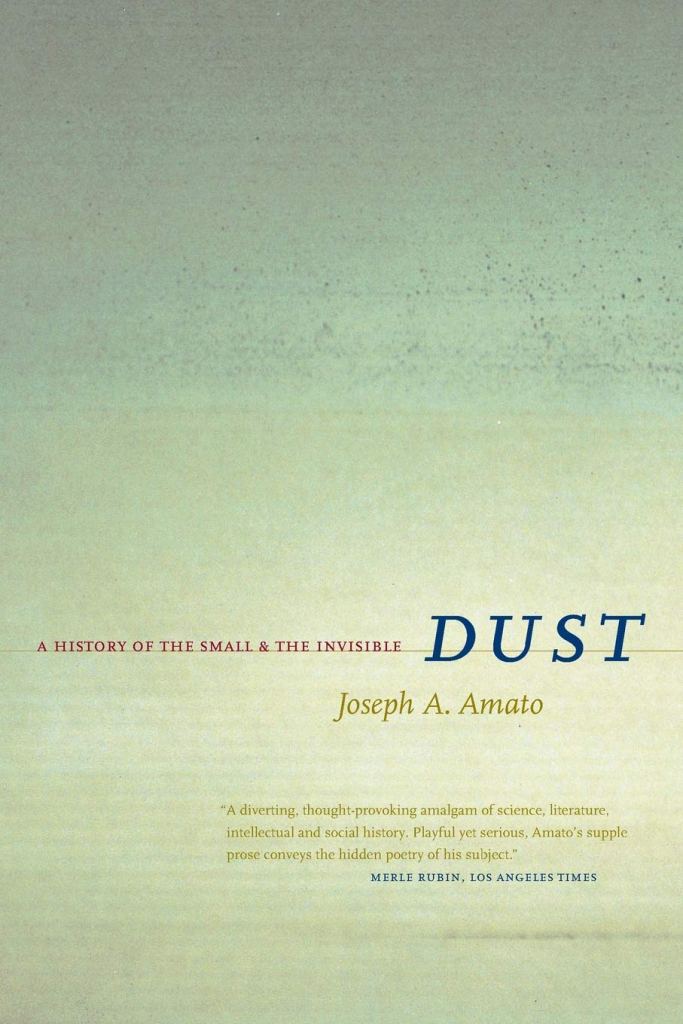
Title: Dust: A History of the Small & The Invisible
Year: 2001
Author: Joseph A. Amato
While the story of the big has often been told, the story of the small has not yet even been outlined. With Dust, Joseph Amato enthralls the reader with the first history of the small and the invisible. Dust is a poetic meditation on how dust has been experienced and the small has been imagined across the ages. Examining a thousand years of Western civilization—from the naturalism of medieval philosophy, to the artistry of the Renaissance, to the scientific and industrial revolutions, to the modern worlds of nanotechnology and viral diseases—Dust offers a savvy story of the genesis of the microcosm.
Dust, which fills the deepest recesses of space, pervades all earthly things. Throughout the ages it has been the smallest yet the most common element of everyday life. Of all small things, dust has been the most minute particulate the eye sees and the hand touches. Indeed, until this century, dust was simply accepted as a fundamental condition of life; like darkness, it marked the boundary between the seen and the unseen.
With the full advent of scientific discovery, technological innovation, and social control, dust has been partitioned, dissected, manipulated, and even invented. In place of traditional and generic dust, a highly diverse particulate has been discovered and examined. Like so much else that was once considered minute, dust has been magnified by the twentieth-century transformations of our conception of the small. These transformations—which took form in the laboratory through images of atoms, molecules, cells, and microbes—defined anew not only dust and the physical world but also the human body and mind. Amato dazzles the reader with his account of how this powerful microcosm challenges the imagination to grasp the magnitude of the small, and the infinity of the finite.
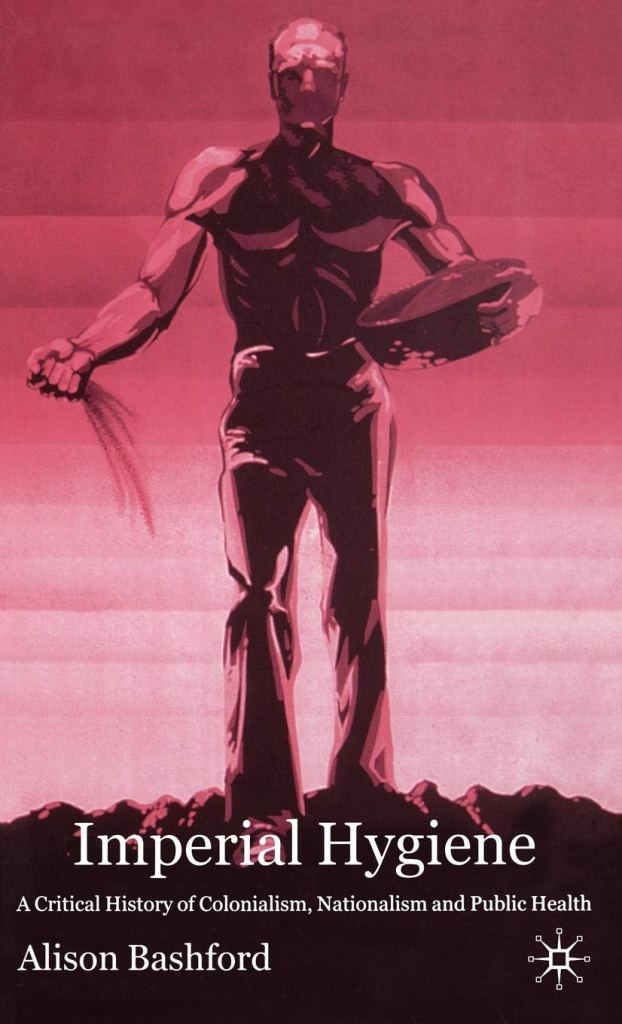
Title: Hygiene: A Critical History of Colonialism, Nationalism and Public Health
Year: 2004
Author: Alison Bashford
This is a cultural history of borders, hygiene and race. It is about foreign bodies, from Victorian Vaccines to the pathologized interwar immigrant, from smallpox quarantine to the leper colony, from sexual hygiene to national hygiene to imperial hygiene. Taking British colonialism and White Australia as case studies, the book examines public health as spatialized biopolitical governance between 1850 and 1950. Colonial management of race dovetailed with public health into new boundaries of rule, into racialised cordons sanitaires.
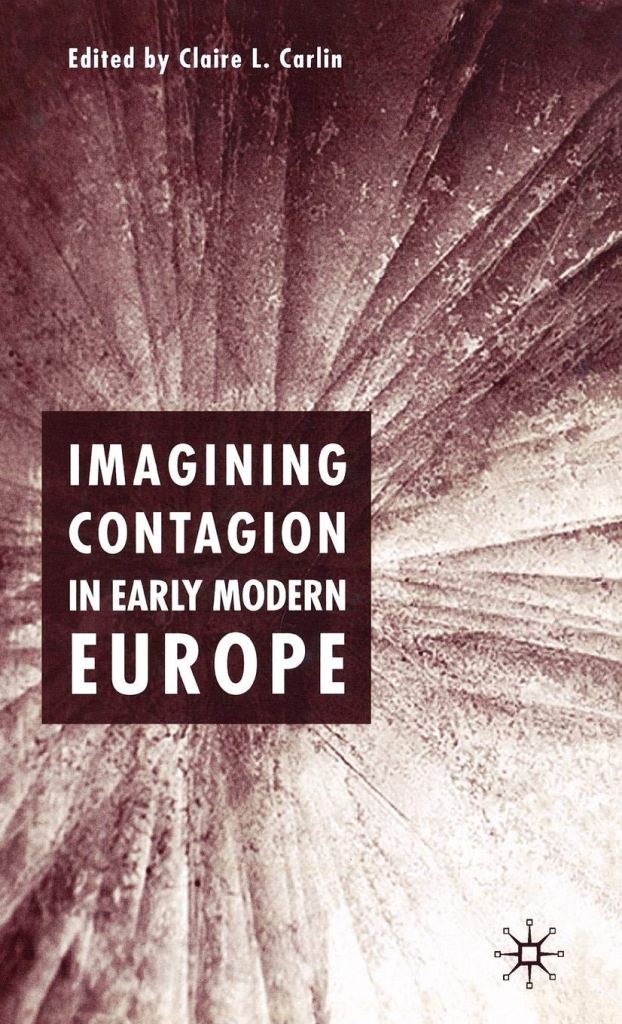
Title: Imagining Contagion in Early Modern Europe
Year: 2005
Edited by Claire L Carlin
The ideological underpinnings of early modern theories of contagion are dissected in this volume by an integrated team of literary scholars, cultural historians, historians of medicine and art historians. Even today, the spread of disease inspires moralizing discourse and the ostracism of groups thought responsible for contagion; the fear of illness and the desire to make sense of it are demonstrated in the current preoccupation with HIV, SARS, ‘mad cow’ disease, West Nile virus and avian flu, to cite but a few contemporary examples. Imagining Contagion in Early Modern Europe explores the nature of understanding when humanity is faced with threats to its well-being, if not to its very survival.
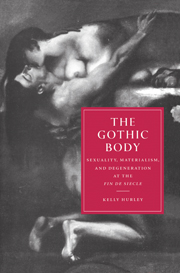
Title: The Gothic Body: Sexuality, Materialism, and Degeneration at the Fin de Siècle (Cambridge Studies in Nineteenth-Century Literature and Culture)
Year: 1997
Author: Kelly Hurley
This book accounts for the resurgence of Gothic, and its immense popularity, during the British fin de siècle. In particular, Kelly Hurley explores a key scenario that haunts the genre: the loss of a unified and stable human identity, and the emergence of a chaotic and transformative ‘abhuman’ identity in its place. Gothic is revealed as a highly productive and speculative genre, strongly indebted to nineteenth-century scientific, medical and social theories, including evolutionism, criminal anthropology and degeneration theory.
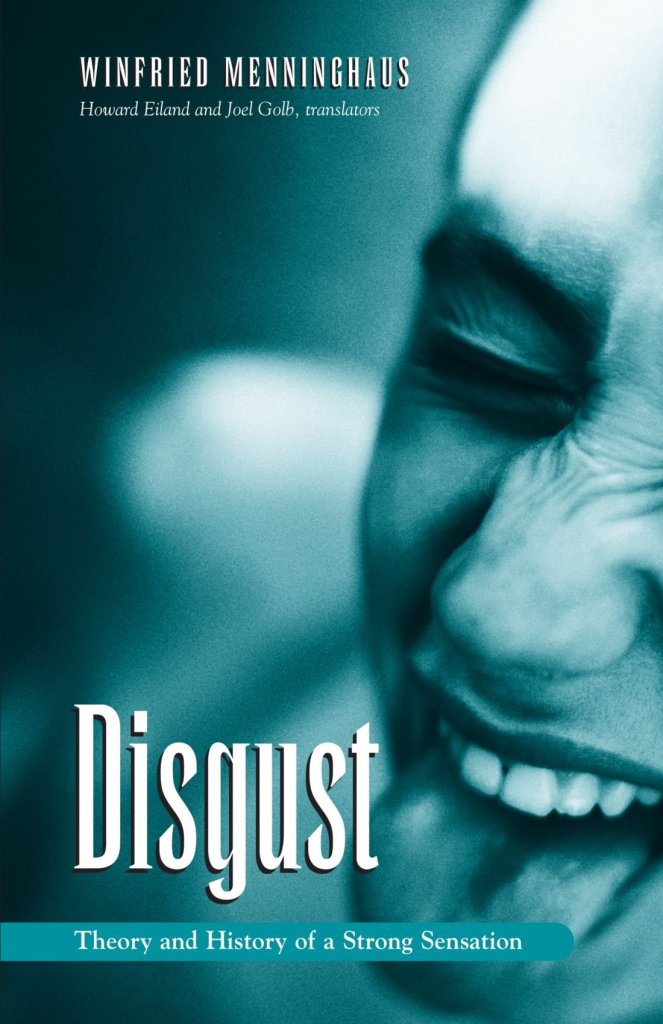
Title: Disgust: Theory and History of a Strong Senstation
Year: 2003
Author: Winfried Menninghaus
Disgust (Ekel, dégoût) is a state of high alert. It acutely says “no” to a variety of phenomena that seemingly threaten the integrity of the self, if not its very existence. A counterpart to the feelings of appetite, desire, and love, it allows at the same time for an acting out of hidden impulses and libidinal drives.
In Disgust, Winfried Menninghaus provides a comprehensive account of the significance of this forceful emotion in philosophy, aesthetics, literature, the arts, psychoanalysis, and theory of culture from the eighteenth century to the present. Topics addressed include the role of disgust as both a cognitive and moral organon in Kant and Nietzsche; the history of the imagination of the rotting corpse; the counter-cathexis of the disgusting in Romantic poetics and its modernist appeal ever since; the affinities of disgust and laughter and the analogies of vomiting and writing; the foundation of Freudian psychoanalysis in a theory of disgusting pleasures and practices; the association of disgusting “otherness” with truth and the trans-symbolic “real” in Bataille, Sartre, and Kristeva; Kafka’s self-representation as an “Angel” of disgusting smells and acts, concealed in a writerly stance of uncompromising “purity”; and recent debates on “Abject Art.”
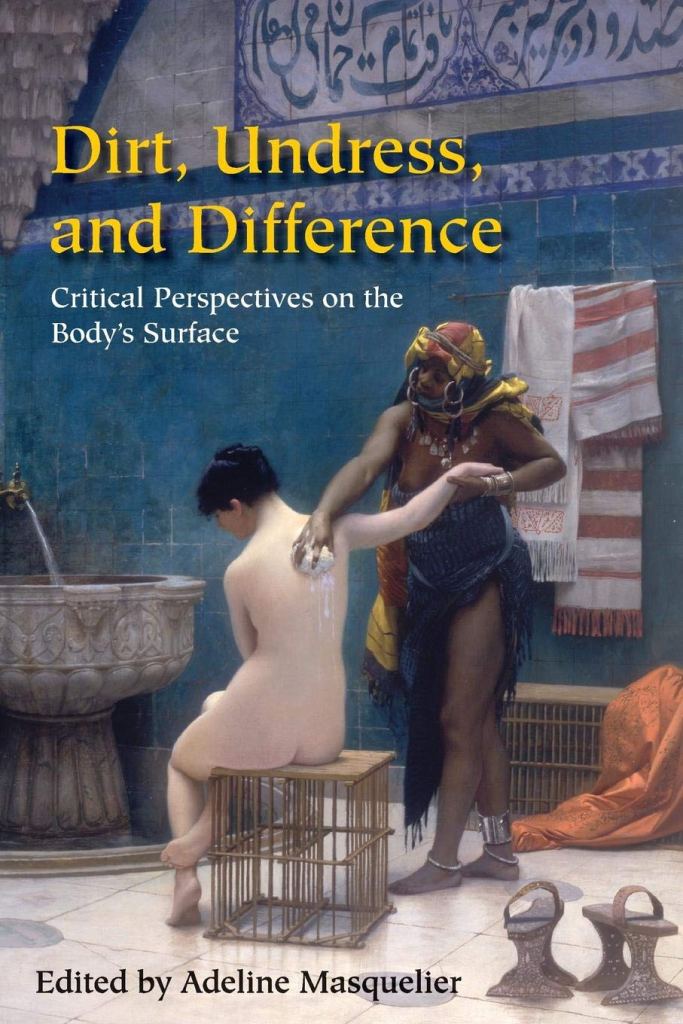
Title: Dirt, Undress, and Difference: Critical Perspectives on the Body’s Surface
Year: 2005
Edited by Adeline Masquelier
“A magnificent volume! It offers brand new perspectives on body politics and identity or subjectivity formation in the post-colonial world.” ―Dorothy Ko, Barnard College
While there is widespread interest in dress and hygiene as vehicles of cultural, moral, and political value, little scholarly attention has been paid to cross-cultural understandings of dirt and undress, despite their equally important role in the fashioning of identity and difference. The essays in this absorbing and thought-provoking collection contribute new insights into the neglected topics of bodily treatments and transgressions. In detailed ethnographic studies from around the world, the contributors recast assumptions about filth and nakedness, exploring how various forms of transgression associated with the body’s surface are drawn up into relations of power and inequality. They demonstrate imaginatively how body surfaces are powerfully mobilized in the making and unmaking of moral worlds.
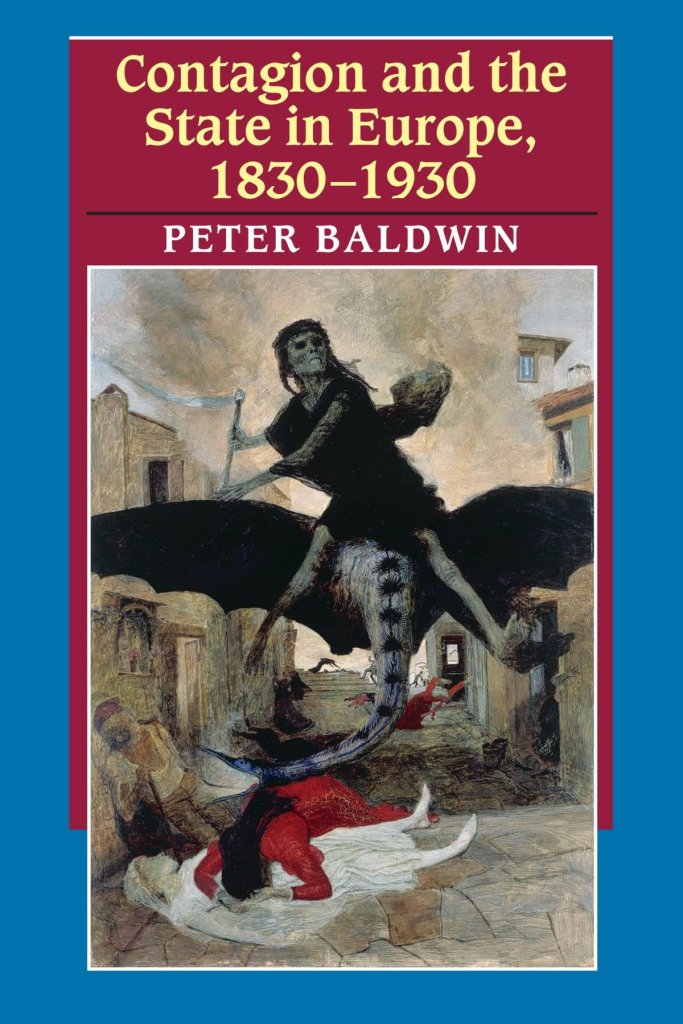
Title: Contagion and State in Europe 1830-1930
Year: 2005
Author: Peter Baldwin
This book explains the historical reasons for the divergence in public health policies adopted in Britain, France, Germany and Sweden, and the spectrum of responses to the threat of contagious diseases such as cholera, smallpox and syphilis. In particular the book examines the link between politics and prevention, and uses medical history to illuminate broader questions of the development of statutory intervention and the comparative and divergent evolution of the modern state in Europe.
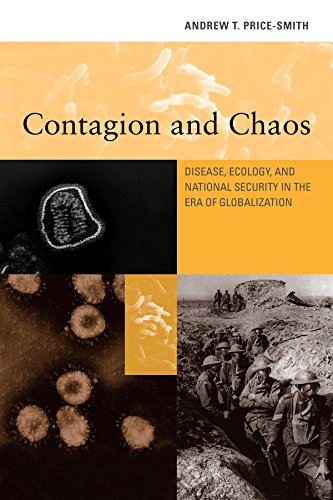
Title: Contagion and Chaos: Disease, Ecology, and National Security in the Era of Globalization
Year: 2009
Author: Andrew T. Price-Smith
An analysis of infectious disease as a threat to national security that examines the destabilizing effects of the 1918 Spanish Flu pandemic, HIV/AIDS in sub-Saharan Africa, SARS, and Mad Cow Disease.
Historians from Thucydides to William McNeill have pointed to the connections between disease and civil society. Political scientists have investigated the relationship of public health to governance, introducing the concept of health security. In Contagion and Chaos, Andrew Price-Smith offers the most comprehensive examination yet of disease through the lens of national security. Extending the analysis presented in his earlier book The Health of Nations, Price-Smith argues that epidemic disease represents a direct threat to the power of a state, eroding prosperity and destabilizing both its internal politics and its relationships with other states. He contends that the danger of an infectious pathogen to national security depends on lethality, transmissability, fear, and economic damage. Moreover, warfare and ecological change contribute to the spread of disease and act as “disease amplifiers.”
Price-Smith presents a series of case studies to illustrate his argument: the Spanish influenza pandemic of 1918-19 (about which he advances the controversial claim that the epidemic contributed to the defeat of Germany and Austria); HIV/AIDS in sub-Saharan Africa (he contrasts the worst-case scenario of Zimbabwe with the more stable Botswana); bovine spongiform encephalopathy (also known as mad cow disease); and the SARS contagion of 2002-03. Emerging infectious disease continues to present a threat to national and international security, Price-Smith argues, and globalization and ecological change only accelerate the danger.
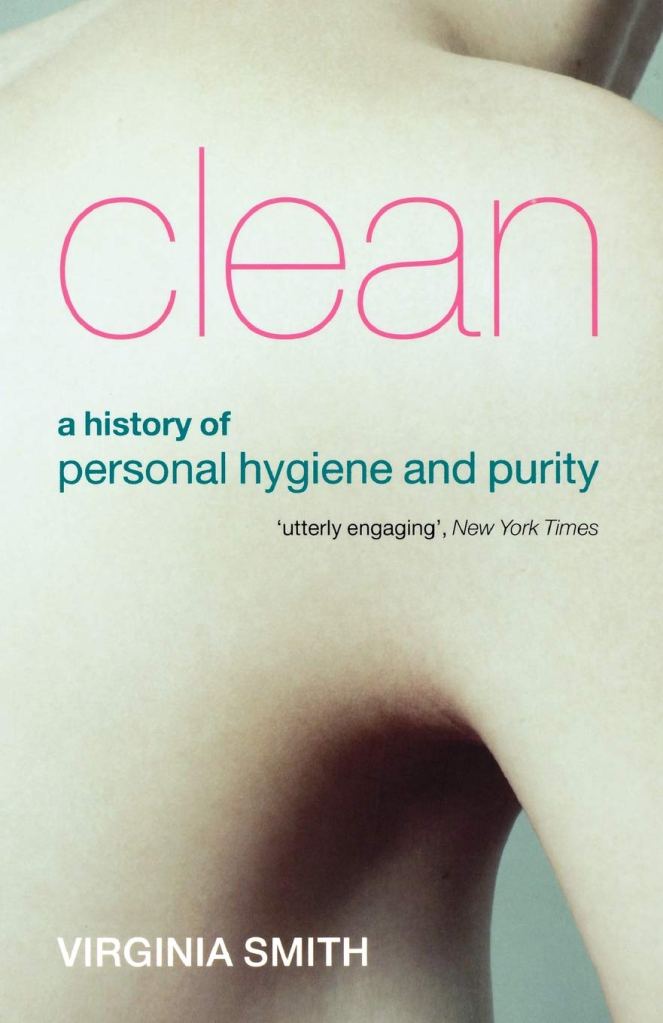
Title: Clean: a history of personal hygiene and purity
Year: 2008
Author: Virginia Smith
In this pioneering book, Virginia Smith combines archeology, psychology, biology, and sociology to reveal how and why standards of cleanliness have come to exist today. Using hundreds of first-hand accounts and sources, Smith bring us from the Neolithic age to the present, peppering her engaging prose with enlightening and often surprising details.
Subconscious cleanliness has been with us since the first cell ejected a foreign invader. Even at the earliest stages of human development, our bodies produced pleasure-giving chemical opiates when things smelled or felt clean, inducing us to do things like bathing and removing dirty clothes. The need to be clean led directly to socialization, as we turned to our fellows for help with those hard to reach spots. In Eurasia during the Bronze Age, an emerging hierarchy of wealthy elites turned their love of grooming into an explosion of the cosmetic and luxury goods industry, greatly effecting the culture and economy of a vast area and leading to advances in chemistry and medicine.
The history that follows, from Greece and Rome, where citizens focused much of their leisure time on perfecting, bathing, or just writing about the model athletic body, through Europe in the middle ages and the following centuries, is full of intriguing customs, convoluted treatises, and many reversals. Baths were good for you, baths were bad for you, baths were good again–but only if they were quite cold. Even the enlightened medical knowledge of modern times could not stop an onslaught of health remedies, treatments, spas, and New Age nature cures that were to follow. While today we are immeasurably closer–perhaps too close–to knowing just what “clean” means to our bodies, we are still just as far as we ever were on agreeing what it means to our souls.
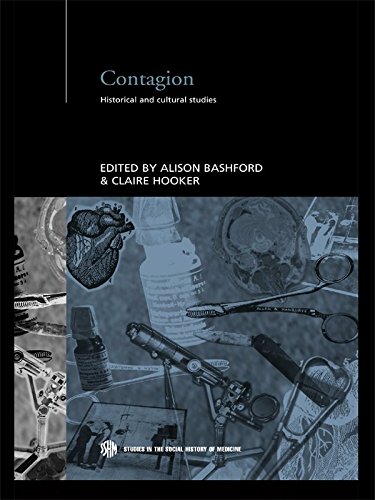
Title: Contagion: Historical and Cultural Studies
Year: 2002
Author: Alison Bashford (Author), Claire Hooker
In the age of HIV, antibiotic-resistant bacteria, the Ebola Virus and BSE, metaphors and experience of contagion are a central concern of government, biomedicine and popular culture.
Contagion explores cultural responses of infectious diseases and their biomedical management over the nineteenth and twentieth centuries. It also investigates the use of ‘contagion’ as a concept in postmodern reconceptualisations of embodied subjectivity.
The essays are written from within the fields of cultural studies, biomedical history and critical sociology. The contributors examine the geographies, policies and identities which have been produced in the massive social effort to contain diseases. They explore both social responses to infectious diseases in the past, and contemporary theoretical and biomedical sites for the study of contagion.
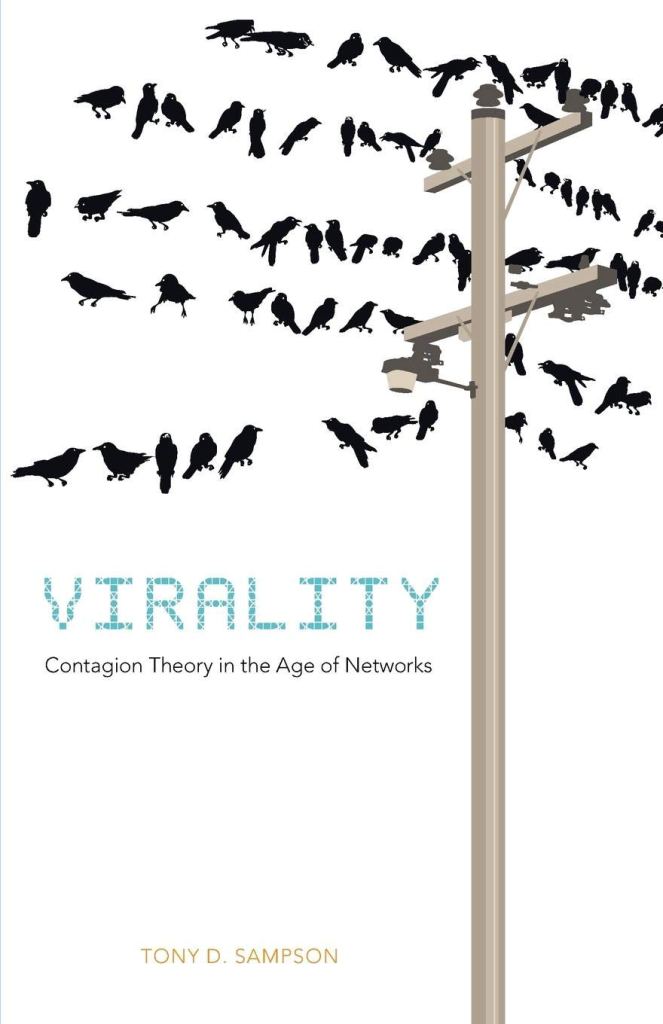
Title: Virality: Contagion Theory in the Age of Networks
Year: 2012
Author: Tony D. Sampson
In this thought-provoking work, Tony D. Sampson presents a contagion theory fit for the age of networks. Unlike memes and microbial contagions, Virality does not restrict itself to biological analogies and medical metaphors. It instead points toward a theory of contagious assemblages, events, and affects. For Sampson, contagion is not necessarily a positive or negative force of encounter; it is how society comes together and relates.
Sampson argues that a biological knowledge of contagion has been universally distributed by way of the rhetoric of fear used in the antivirus industry and other popular discourses surrounding network culture. This awareness is also detectable in concerns over too much connectivity, such as problems of global financial crisis and terrorism. Sampson’s “virality” is as established as that of the biological meme and microbe but is not understood through representational thinking expressed in metaphors and analogies. Rather, Sampson interprets contagion theory through the social relationalities first established in Gabriel Tarde’s microsociology and subsequently recognized in Gilles Deleuze’s ontological worldview.
According to Sampson, the reliance on representational thinking to explain the social behavior of networking—including that engaged in by nonhumans such as computers—allows language to overcategorize and limit analysis by imposing identities, oppositions, and resemblances on contagious phenomena. It is the power of these categories that impinges on social and cultural domains. Assemblage theory, on the other hand, is all about relationality and encounter, helping us to understand the viral as a positively sociological event, building from the molecular outward, long before it becomes biological.
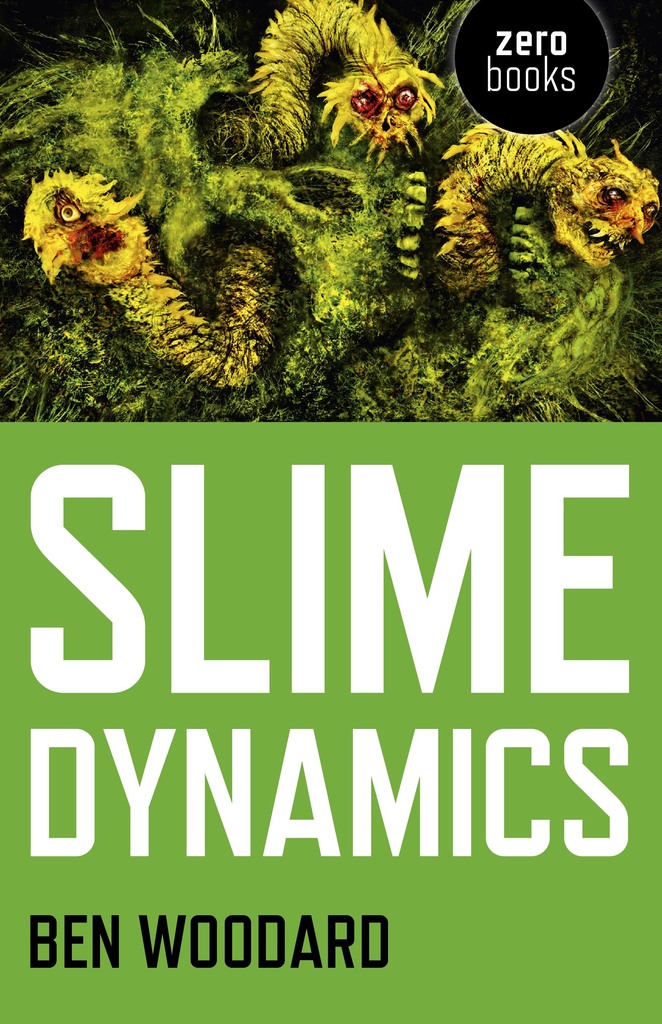
Title: Slime Dynamics: Generation, Mutation, and the Creep of Life
Year: 2012
Author: Ben Woodard
Despite humanity’s gradual ascent from clustered pools of it, slime is more often than not relegated to a mere residue—the trail of a verminous life form, the trace of decomposition, or an entertaining synthetic material—thereby leaving its generative and mutative associations with life neatly removed from the human sphere of thought and existence. Arguing that slime is a viable physical and metaphysical object necessary to produce a realist bio-philosophy void of anthrocentricity, this text explores naturephilosophie, speculative realism, and contemporary science; hyperbolic representations of slime found in the weird texts of HP Lovecraft and Thomas Ligotti; as well as survival horror films, video games, and graphic novels, in order to present the dynamics of slime not only as the trace of life but as the darkly vitalistic substance of life.
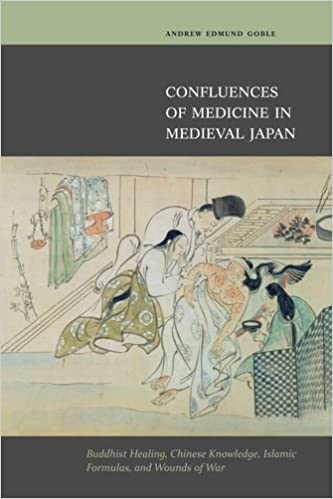
Title: Confluences of Medicine in Medieval Japan: Buddhist Healing, Chinese Knowledge, Islamic Formulas, and Wounds of War
Year: 2011
Author: Andrew Edmund Goble
Confluences of Medicine is the first book-length exploration in English of issues of medicine and society in premodern Japan. This multifaceted study weaves a rich tapestry of Buddhist healing practices, Chinese medical knowledge, Asian pharmaceuticals, and Islamic formulas as it elucidates their appropriation and integration into medieval Japanese medicine. It expands the parameters of the study of medicine in East Asia, which to date has focused on the subject in individual countries, and introduces the dynamics of interaction and exchange that coursed through the East Asian macro-culture.
The book explores these themes primarily through the two extant works of the Buddhist priest and clinical physician Kajiwara Shozen (1265-1337), who was active at the medical facility housed at Gokurakuji temple in Kamakura, the capital of Japan’s first warrior government. With access to large numbers of printed Song medical texts and a wide range of materia medica from as far away as the Middle East, Shozen was a beneficiary of the efflorescence of trade and exchange across the East China Sea that typifies this era. His break with the restrictions of Japanese medicine is revealed in Ton’isho (Book of the simple physician) and Man’apo (Myriad relief formulas). Both of these texts are landmarks: the former being the first work written in Japanese for a popular audience; the latter, the most extensive Japanese medical work prior to the seventeenth century.
Confluences of Medicine brings to the fore the range of factors–networks of Buddhist priests, institutional support, availability of materials, relevance of overseas knowledge to local conditions of domestic strife, and serendipity–that influenced the Japanese acquisition of Chinese medical information. It offers the first substantive portrait of the impact of the Song printing revolution in medieval Japan and provides a rare glimpse of Chinese medicine as it was understood outside of China. It is further distinguished by its attention to materia medica and medicinal formulas and to the challenges of technical translation and technological transfer in the reception and incorporation of a new pharmaceutical regime.
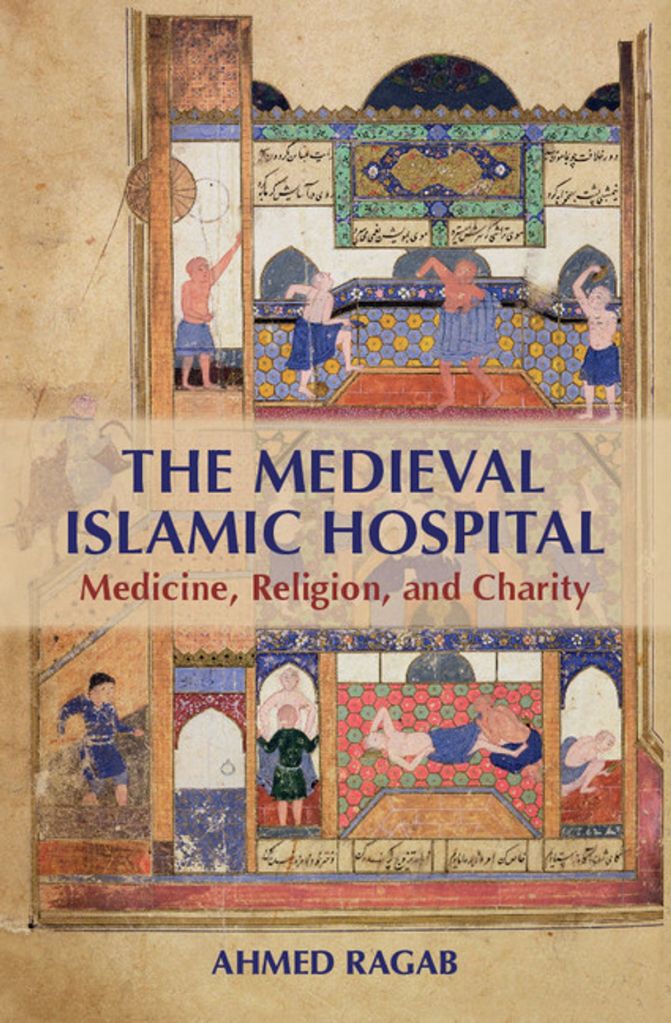
Title: The Medieval Islamic Hospital: Medicine, Religion, and Charity
Year: 2015
Author: Ahmed Ragab
The first monograph on the history of Islamic hospitals, this volume focuses on the under-examined Egyptian and Levantine institutions of the twelfth to fourteenth centuries. By the twelfth century, hospitals serving the sick and the poor could be found in nearly every Islamic city. Ahmed Ragab traces the varying origins and development of these institutions, locating them in their urban environments and linking them to charity networks and patrons’ political projects. Following the paths of patients inside hospital wards, he investigates who they were and what kinds of experiences they had. The Medieval Islamic Hospital explores the medical networks surrounding early hospitals and sheds light on the particular brand of practice-oriented medicine they helped to develop. Providing a detailed picture of the effect of religion on medieval medicine, it will be essential reading for those interested in history of medicine, history of Islamic sciences, or history of the Mediterranean.
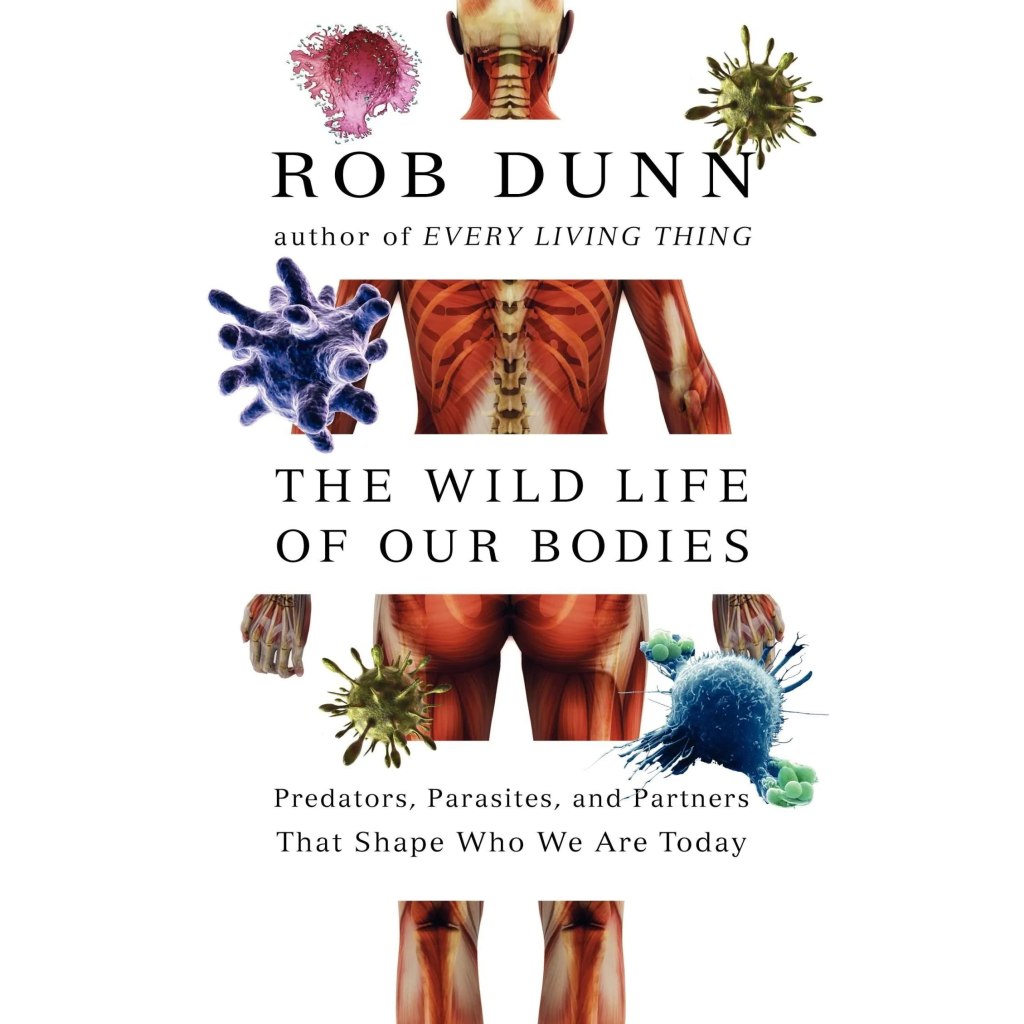
Title: The Wild Life of Our Bodies: Predators, Parasites, and Partners That Shape Who We Are Today
Year: 2011
Author: Robert Dunn
“An extraordinary book…. With clarity and charm [Dunn] takes the reader into the overlap of medicine, ecology, and evolutionary biology to reveal an important domain of the human condition.” —Edward O. Wilson, author of Anthilland The Future of Life
Biologist Rob Dunn reveals the crucial influence that other species have upon our health, our well-being, and our world in The Wild Life of Our Bodies—a fascinating tour through the hidden truths of nature and codependence. Dunn illuminates the nuanced, often imperceptible relationships that exist between homo sapiens and other species, relationships that underpin humanity’s ability to thrive and prosper in every circumstance. Readers of Michael Pollan’s The Omnivore’s Dilemma will be enthralled by Dunn’s powerful, lucid exploration of the role that humankind plays within the greater web of life on Earth.
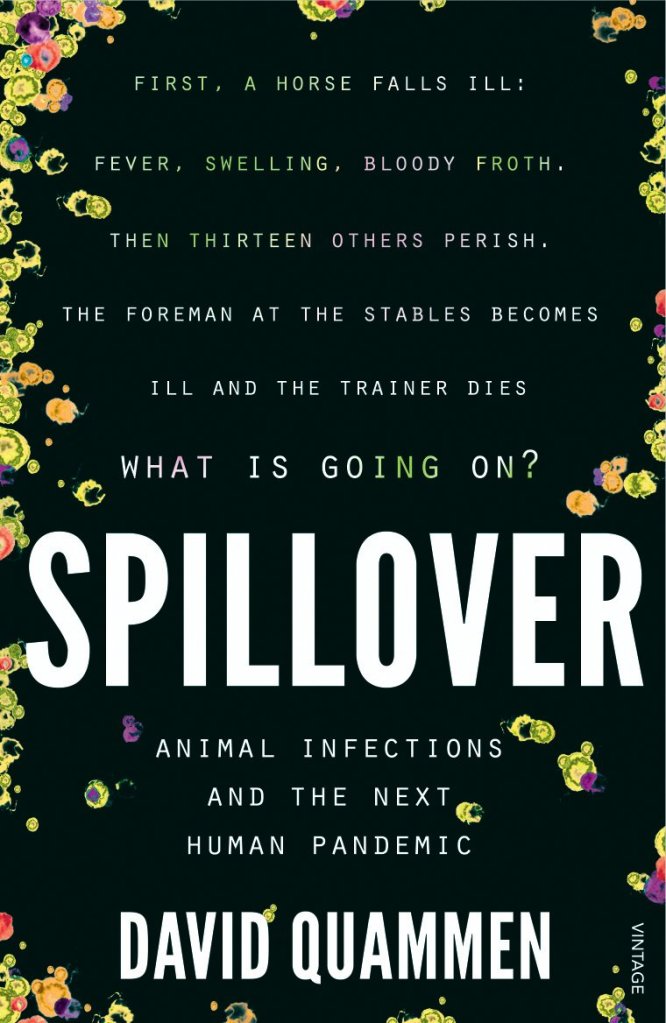
Title: Spillover – Animal Infections and the Next Human Pandemic
Year: 2012
Author: David Quammen
Ebola, SARS, Hendra, AIDS, and countless other deadly viruses all have one thing in common: the bugs that transmit these diseases all originate in wild animals and pass to humans by a process called spillover. In this gripping account, David Quammen takes the reader along on this astonishing quest to learn how, where from, and why these diseases emerge and asks the terrifying question: What might the next big one be?
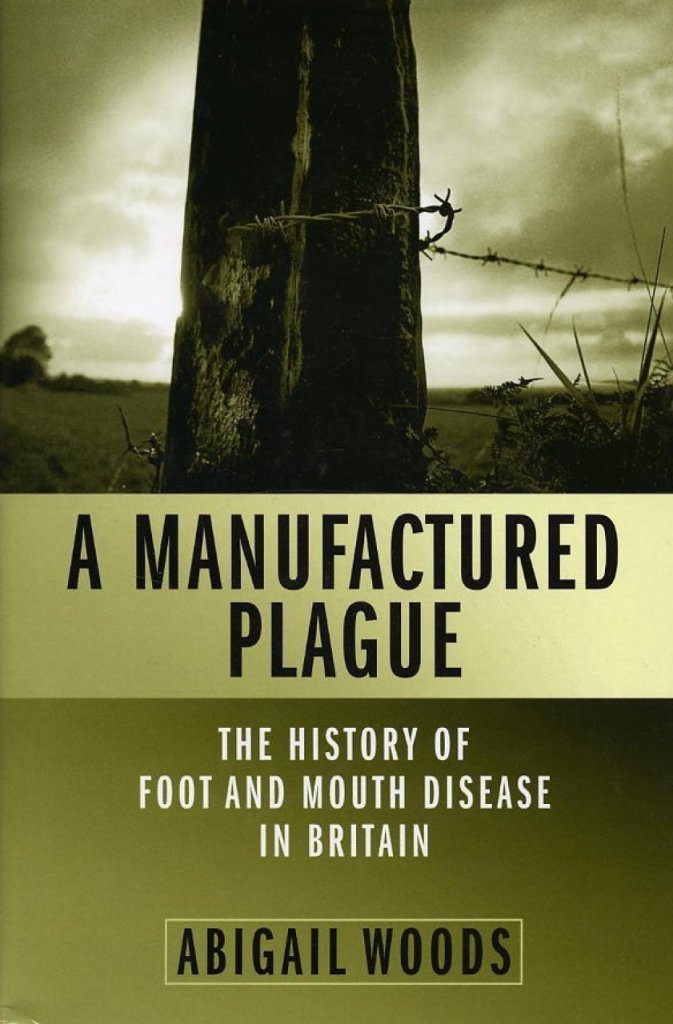
Title: A Manufactured Plague: The History of Foot and Mouth Disease in Britain
Year: 2004
Author: Abigail Woods
Foot and mouth disease (FMD) is currently regarded as one of the world’s worst animal plagues. But how did this label become attached to a curable disease that poses little threat to human health? And why, in the epidemic of 2001, did the government’s control strategy still rely upon Victorian trade restrictions and mass slaughter? This groundbreaking and well-researched book shows that, for over a century, FMD has brought fear, tragedy and sorrow- damaging businesses and affecting international relations. Yet these effects were neither inevitable nor caused by FMD itself but were, rather, the product of the legislation used to control it, and in this sense FMD is a ‘manufactured’ plague rather than a natural one. A Manufactured Plague turns the spotlight on this process of manufacture, revealing a rich history beset by controversy, in which party politics, class relations, veterinary ambitions, agricultural practices, the priorities of farming and the meat trade, fears for national security and scientific progress all made FMD what it is today.
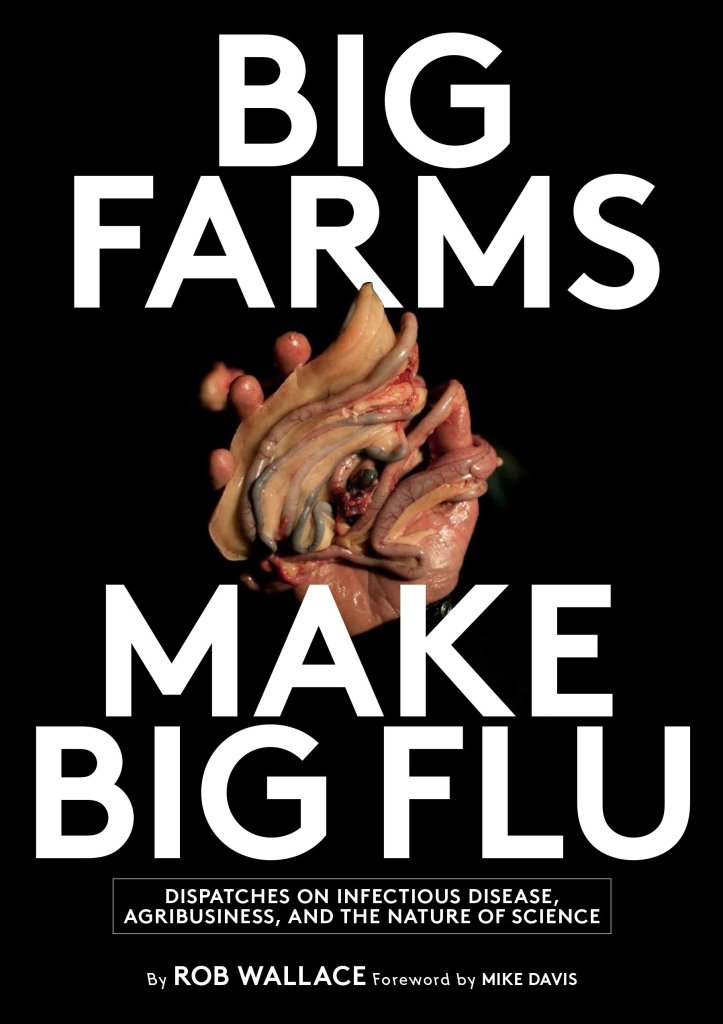
Title: Big Farms Make Big Flu: Dispatches on Infectious Disease, Agribusiness, and the Nature of Science
Year: 2016
Author: Rob Wallace
Thanks to breakthroughs in production and food science, agribusiness has been able to devise new ways to grow more food and get it more places more quickly. There is no shortage of news items on hundreds of thousands of hybrid poultry – each animal genetically identical to the next – packed together in megabarns, grown out in a matter of months, then slaughtered, processed and shipped to the other side of the globe. Less well known are the deadly pathogens mutating in, and emerging out of, these specialized agro-environments. In fact, many of the most dangerous new diseases in humans can be traced back to such food systems, among them Campylobacter, Nipah virus, Q fever, hepatitis E, and a variety of novel influenza variants.
Agribusiness has known for decades that packing thousands of birds or livestock together results in a monoculture that selects for such disease. But market economics doesn’t punish the companies for growing Big Flu – it punishes animals, the environment, consumers, and contract farmers. Alongside growing profits, diseases are permitted to emerge, evolve, and spread with little check. “That is,” writes evolutionary biologist Rob Wallace, “it pays to produce a pathogen that could kill a billion people.”
In Big Farms Make Big Flu, a collection of dispatches by turns harrowing and thought-provoking, Wallace tracks the ways influenza and other pathogens emerge from an agriculture controlled by multinational corporations. Wallace details, with a precise and radical wit, the latest in the science of agricultural epidemiology, while at the same time juxtaposing ghastly phenomena such as attempts at producing featherless chickens, microbial time travel, and neoliberal Ebola. Wallace also offers sensible alternatives to lethal agribusiness. Some, such as farming cooperatives, integrated pathogen management, and mixed crop-livestock systems, are already in practice off the agribusiness grid.
While many books cover facets of food or outbreaks, Wallace’s collection appears the first to explore infectious disease, agriculture, economics and the nature of science together. Big Farms Make Big Flu integrates the political economies of disease and science to derive a new understanding of the evolution of infections. Highly capitalized agriculture may be farming pathogens as much as chickens or corn.
